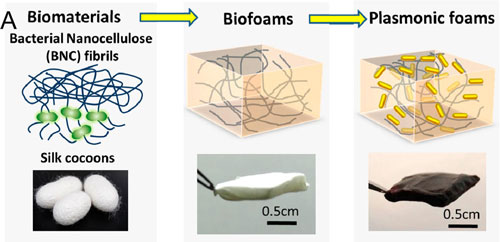| Posted: Dec 16, 2015 | |
Plasmonic biofoam beats conventional plasmonic surfaces |
|
| (Nanowerk Spotlight) So far, most of the applications of plasmonic nanostructures rely on solid two-dimensional (2-D) substrates such as silicon, glass, plastic, or paper. Such substrates offer rather limited accessible surface area, thus severely limiting the volumetric density of the nanostructures. | |
| "To address this issue, we have introduced a novel optically-active 3D material with a high density of plasmonic nanostructures that can be treated as a frozen solution of metal nanostructures in which the nanostructures are completely accessible," Dr. Rajesh R. Naik of the Air Force Research Laboratory (AFRL), tells Nanowerk. "We believe that this 3-D plasmonic biofoam opens up lots of opportunities in using the unique optical properties of plasmonic nanostructures." | |
| Naik, who is Chief Scientist, 711th Human Performance Wing, AFRL at Wright-Patterson Air Force Base in Dayton, Ohio together with Professor Srikanth Singamaneni from the Washington University in St. Louis, and their teams, have demonstrated that the SERS and photothermal performance of this novel 3-D material is superior compared to that of conventional 2-D plasmonic surfaces. | |
| The researchers have published their findings in the December 2, 2015 online edition of Nano Letters ("Plasmonic Biofoam: A Versatile Optically Active Material"). | |
 |
|
| Schematic illustration showing the fabrication of plasmonic biofoams. (Reprinted with permission by American Chemical Society) | |
| This novel, optically active multifunctional material platform is based on biomaterial foam which can be created from various biopolymers, in this case bacterial nanocellulose and regenerated silk fibroin. The nanocellulose material is processed into freeze-dried aerogel and then uniformly coated with a high density of plasmonic nanostructures (in this case gold nanorods). | |
| "The highly open porous structure of the biomaterial foam combined with high volumetric density of nanostructures makes plasmonic foam a solid-state analogue of highly concentrated solution of plasmonic nanostructures," notes Singamaneni. | |
| This approach opens the door for using biocompatible materials as bioplasmonic foams that can be used in a variety of applications, mainly in biomedical and energy harvesting investigations. | |
| Naik and his collaborators see three main application areas for the new material platform: | |
| 1) Plasmonic biofoam, owing to the high density of plasmonic nanostructures, is ideally suited for chemical and biological sensing based on surface enhanced Raman scattering (SERS); | |
| 2) The large and tunable absorption of plasmonic nanostructures combined with high photothermal efficiency of these nanostructures make plasmonic biofoam an excellent candidate for solar energy harvesting and photothermal steam generation; | |
| 3) The ability of loading and releasing cargo from these materials with external triggers, such as light, makes them excellent carriers for catalysts and drugs, for example, optically triggered release of entrapped reagents in wound dressings. | |
| In this present work, the team has employed plasmonic nanostructures to achieve optically active biofoams. However, the functionality of the biofoams can be broadened with the incorporation of other functional nanomaterials such as graphene, carbon nanotubes and catalytically active nanomaterials. | |
| "We would like to explore the use of other nanomaterials, making the aerogels more robust and creating other 3D hybrid functional materials using this approach," says Naik. | |
| Also, in this study, the thickness of the plasmonic foam is higher than the light penetration depth. To minimize the amount of nanostructures employed, in a next step the researchers will limit the nanostructures to the top portion of the aerogel while the bottom portion will serve as a support layer. | |
| "We have employed gold nanorods as plasmonic materials in this study; considering that gold is an expensive material, it would be ideal to replace gold with other materials that are relatively inexpensive, while preserving the unique optical properties of these functional aerogels," concludes Singamaneni. "A lot of efforts have been made in recent years in developing inexpensive plasmonic materials. These developments would certainly broaden the applications of plasmonic materials and plasmonic biofoams." | |
 By
Michael
Berger
– Michael is author of three books by the Royal Society of Chemistry:
Nano-Society: Pushing the Boundaries of Technology,
Nanotechnology: The Future is Tiny, and
Nanoengineering: The Skills and Tools Making Technology Invisible
Copyright ©
Nanowerk LLC
By
Michael
Berger
– Michael is author of three books by the Royal Society of Chemistry:
Nano-Society: Pushing the Boundaries of Technology,
Nanotechnology: The Future is Tiny, and
Nanoengineering: The Skills and Tools Making Technology Invisible
Copyright ©
Nanowerk LLC
|
|
|
Become a Spotlight guest author! Join our large and growing group of guest contributors. Have you just published a scientific paper or have other exciting developments to share with the nanotechnology community? Here is how to publish on nanowerk.com. |
|
